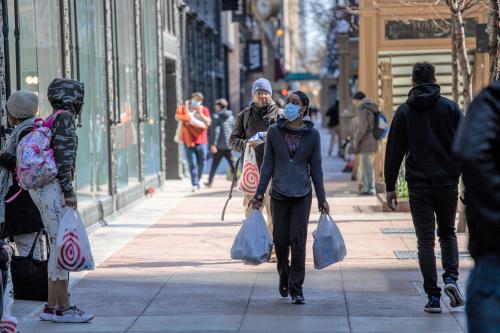Employers across America’s largest metro areas added nearly 453,000 workers to their payrolls in March. This marked the largest monthly addition to job totals in the nation’s 191 largest metro areas since October, and is a sign that a steady recovery from the pandemic recession is underway as vaccination rates increase, stimulus checks flow to households, and businesses reopen.
March’s jobs uptick continues an upward trend in employment in 2021 after employment gains slowed down at the end of 2020. Large metro area economies added 321,500 jobs in January and 371,000 jobs in February. However, even with the increasingly bright labor market outlook, many metro area economies—particularly those dominated by the hardest-hit industries—still have a long way to go to fully recover.
Job totals in most metro areas remain well below their pre-pandemic baseline
Even with last month’s increase, total nonfarm employment in the largest metro areas remains more than 7.5 million jobs (or 6.4%) short of pre-pandemic levels from February 2020. Very large metro areas (those with populations of at least 1 million) remain most affected, with employment close to 7% below pre-pandemic levels, compared to job deficits closer to 5% in midsized (250,000 to 499,999 population) and large (500,000 to 999,999 population) metro areas.
Figure 1 visualizes the percent change in employment from February 2020 to March 2021 across the 191 largest metro areas. Tourism hubs such as New York, Las Vegas, Orlando, Fla., Honolulu, and Atlantic City, N.J. are among the metro areas where jobs remained more than 10% below pre-pandemic levels in March. Meanwhile, many metro areas across the South and in Utah are close to recovery, with jobs less than 2% below pre-pandemic levels. Five large and midsized metro areas exceeded pre-pandemic levels of total employment in March: Boise City, Idaho; Lakeland, Fla.; Ogden, Utah; Provo-Orem, Utah; and Waco, Texas.

Leisure and hospitality added the most jobs in March, but remains farthest below its pre-pandemic employment level
While most major economic sectors added jobs in March 2021, leisure and hospitality—the sector that has borne the brunt of pandemic-induced job loss—posted the strongest gains, adding 325,000 jobs nationally. Leisure and hospitality alone accounted for more than one-third of net job gains over the month.
Even so, the largest metro areas had 2.7 million fewer leisure and hospitality jobs in March than one year before. Declines in leisure and hospitality jobs still make up nearly 40% of total job losses since the start of the pandemic. With COVID-19 continuing to limit events and travel, regions that rely heavily on entertainment, recreation, accommodations, and food service sectors remain farthest below their pre-pandemic employment levels. Metro areas in which job losses in these sectors account for more than two-thirds of all job loss include major tourism hubs such as Las Vegas, Myrtle Beach, S.C., Nashville, Tenn., and Tampa-St. Petersburg, Fla.

To be sure, many other sectors contributed to March job gains, indicating that recovery is broader than Americans simply returning to restaurants and travel. Mining, logging, and construction businesses hired 145,000 new workers, while the professional and business services sector added another 120,700 employees (see Figure 3).

Even with sustained progress, complete jobs recovery may be months or years away
Although March job gains were relatively broad-based, 30 of the 191 metro areas failed to add jobs at all that month. Florida’s Ocala and Pensacola metro areas posted nearly 0.5% drops in employment, while New Orleans and Baton Rouge in Louisiana lost 900 and 600 jobs, respectively—marking their second monthly declines this year.
As this inconsistent progress suggests, the road toward a full labor market recovery in metro areas may be a long and complicated one. Figure 4 shows a scenario in which the 191 metro areas replicate their total March employment gains (453,000 jobs) in future months. Even at that robust growth rate, it would still take an estimated 18 months (until September 2022) to return to pre-pandemic job levels.

Of course, individual metro areas are recovering at different rates. If each replicated its own March job gains in future months, 71 metro areas would reach their pre-pandemic job levels within the year. Another 45 would take between one and two years to recover. A further 40 would take more than two years to recover. And the 30 metro areas that failed to add jobs in March will need to start doing so before they can project how long a full recovery might take.

Metro area economies aren’t out of the woods yet
The upcoming April 2021 jobs report may point to a further acceleration of job gains as vaccination rates continue to rise, COVID-19 cases continue to fall, and more people safely return to work. But the differential impacts of the crisis across sectors and places—particularly, the devastating effects of the pandemic on leisure and hospitality businesses, workers, and regional hubs—suggest the potential for a protracted recovery period in many U.S. metro area economies.








Commentary
Promising job numbers are hiding a slow recovery for many metro areas
May 6, 2021